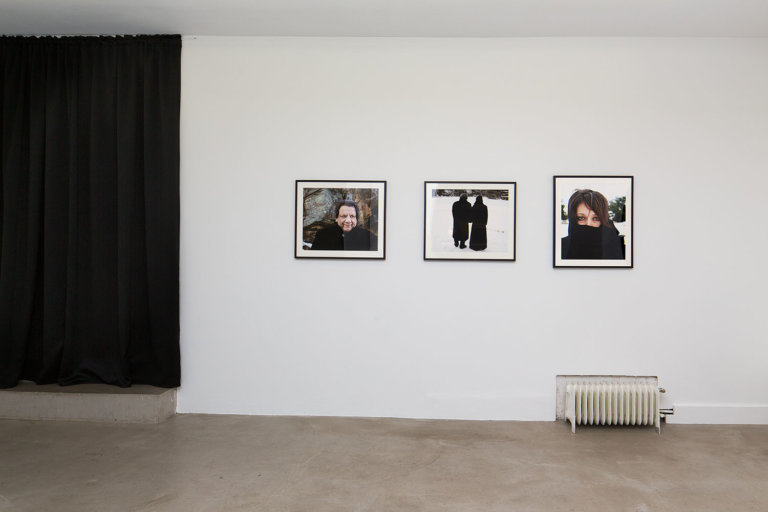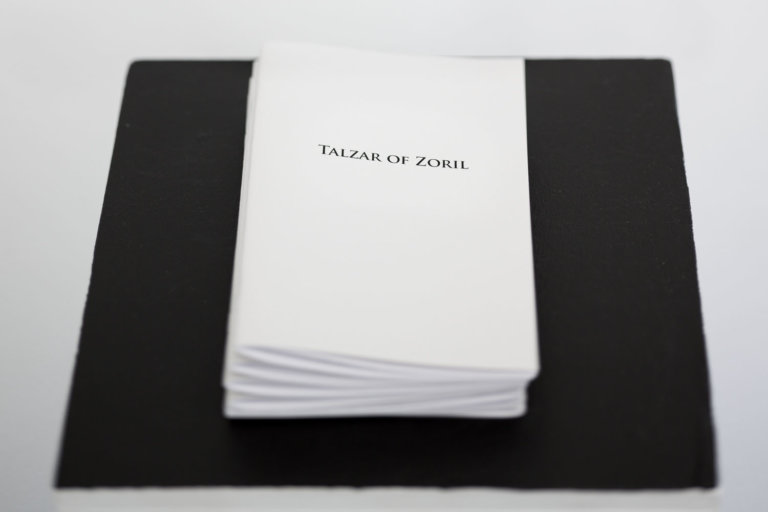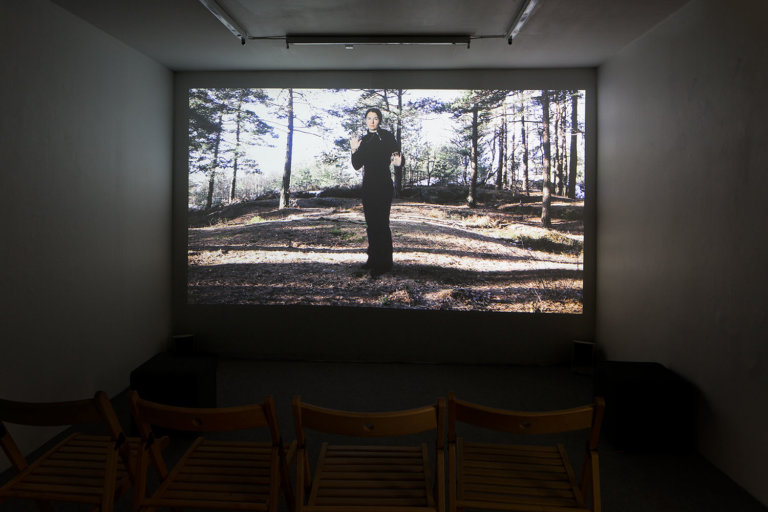The Making of Talzar skildrar Amerikanska konstnären Amanda Hermans djupgående utbyte med Saad Muhialdin. Sedan Muhialdin flydde från Irak under Gulfkriget har han skapat en episk, allegorisk science-fiction berättelse som utforskar ideer kring exil, krig och sökandet efter fred. Berättelsen består av en fantasivärld med gestalter och handlingar baserade på Muhialdins upplevelser, drömmar och erfarenheter av att vara flykting i Sverige. Resultatet av Herman och Muhialdins samarbete är skapandet av kartor, dräkter, objekt från berättelsen (bland annat en prototyp av en tidsmaskin) och en kortfilm. Projektet undersöker personliga trauma, frustration och ensamheten av påtvingad migration och ifrågasätter metoder för flyktingassimilation. Filmen använder sig av ett liknande format som det i bakomkulisserna-filmer som ofta finns med som extra material på DVDer.
I filmen som är inspelad i Göteborg, flätas intervjuer med Muhialdin samman med hittat bildmaterial, animationer och fantasiscener ur själva berättelsen. Förutom filmen innehåller utställningen på Galleri Box fotografier, teckningar, dräkter och objekt.
Amanda Herman synliggör komplexa sociala problem genom att arbeta direkt med samhällsgrupper och individer för att skapa filmer, fotografier och interventioner i det offentliga rummet. Parallellt med sitt konstnärskap har hon över tolv års erfarenhet av att arbeta med socialt utsatta grupper i San Francisco. Herman har en MFA i Social Practice från California College of the Arts, där hon även undervisade mellan 2008-2011. På Akademin Valand deltog hon i Independent Study Course 2007-08 och har de senaste fyra åren varit gäst-lärare på Masterprogrammet. Hennes egna och kollaborativa verk har visats på The Patricia Sweetow Gallery, Yerba Buena Center for the Arts, Museum of the African Diaspora, och New Langton Art Gallery i San Francisco, samt på andra Amerikanska och internationella arenor.
Välkommen på vernissage, kl 18-21 Fredagen den 11 oktober 2013
Interview with Amanda Herman by Josefina Posch
Josefina Posch (JP) Your exhibition at Box takes it´s title from your film “The Making of Talzar” in which Saad Muhialdin is the central character. How did you and Saad meet?
Amanda Herman (AH) Saad and I met while I was a post-graduate fellow at Valand School of Fine Arts – Gothenburg University. I was interested in doing an audio tour mapping project with a group of new immigrants in Sweden and my advisor Leslie Johnson recommended I meet Saad. He taught courses for new immigrants and was part of the bob cultural center in Bergsjön. My original idea never materialized – after meeting Saad I instead dove into a project with him.
(JP) What was it that you found especially interesting with his story?
(AH) We originally met to discuss my ideas and see if Saad would introduce me to his students. It was 2007, at the height of the Iraqi war. He was very interested to hear my (an American) perspective on the US’s invasion. Through the conversation it became clear to us that there were tragic misunderstandings on both sides (Iraqi and US) primarily to do with the governments’ role vs the will of the people. During that first conversation he also told me parts of his own journey from Iraq to Sweden and about the science-fiction novel he was writing. Saad explained that the fictional world he’d created and the primary plot challenges of war, exile and isolation, mirrored his own experience as a refugee to Sweden. He also said he needed help completing the story. Even though we were taking on this immense challenge in a fictional world, we both thought it would be symbolic for an Iraqi and an American to work on a project together – especially one whose main purpose was to search for peace.
I was intrigued by his stories (the real and imagined versions) and by the possibility of a unique collaboration.
(JP) How did you decide to do the making of as oppose to filming his screenplay as a traditional film?
(AH) From the beginning, I was most interested in the complex allegory Saad had created. I wanted to find a way to highlight this – using the fictional story to bring up questions and challenges we felt were shared by many refugees and new immigrants worldwide. We wanted the project to do many things – to present the world of Zoril and the wizard Talzar, to critique the war on Iraq, to talk about the struggle of refugees in Sweden, to tell Saad’s personal story.
The best way I could think of to attempt all this was to build in a narrator, similar to the structure of a “making of” short. The final piece is not really a making of at all – I left out many of the troupes that make up that format. Instead, it’s Saad recounting the plot of the sci-fi story that drives the film, shown in multiple ways: sections we could film (with amateur actors on location in Gothenburg), illustrations and found footage.
(JP) Is this similar to how you normally work?
(AH) My work has always been based in collaborations, often with people who do not consider themselves artists. My background, however, was rooted in journalism and documentary work.
This project was a first for me on many levels – first launch into creating science-fiction (and any fiction at all) , first project where I appear as a character within the story, and my first international, multi-year collaboration – not to mention it’s the longest project I’ve ever worked on. This collaboration also pushed me to make objects and use non-traditional modes of storytelling (filming my hand drawing parts of the story, using found footage, collaging disparate pieces together to compose the narrative). I was most excited about the team we built around the project – Gothenburg artist Haky Jasim drew original sketches and storyboards in the first year of the project, artist Sophy Naess made costumes, artist Lina Persson did special effects, musician Peter Surla composed an original score, Chris Bishop drew illustrations, and many others.
(JP) So making objects is not normally part of your artistic practice? Could you tell me some more about the objects you made and how you decided to include them in your exhibition at Galleri Box?
(AH) My work up to this point was exclusively photography, film and sound. Almost immediately this project was a departure from from standard practice. One of the first things Saad and I made together was his wizard costume and headpiece for an early exhibition about the project at Alma Löv in 2008. The costume was made from recycled materials found in Gothenburg second hand shops. Then, using sketches drawn by Saad and myself, it was designed and sewn together by artist Sophy Naess. With Sophy, we developed a symbol for the wizard based on a wall hanging Saad had brought with him from Iraq. We screenprinted this design onto the costume and it was later used on the medallion I had made years later.
In 2011, I was an artist-in-residence at Northwestern University in Chicago. This provided me with crucial support for the project – time and funds to hire Peter Surla to compose an original soundtrack, Lina Persson to do special effects and for a Chicago artist, Nancy Sikbert-Wheeler, to construct the magical medallion. The medallion is the most powerful and mysterious object in Saad’s story. It makes it possible for the characters to travel through time and holds the secret to finding a valuable, sustainable energy source – and it is the reason the villans in the story are pursuing Talzar and his friends.
The exhibition at Box is the culmination of a five-year collaborative project between Saad and myself. I feel very fortunate to display the work here in Gothenburg and to have the space to feature not only the film, but a selection of the photographs, the medallion and the Talzar of Zoril book which outlines the story and aims to give context to the project as a whole.
© Hendrik Zeitler





